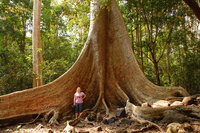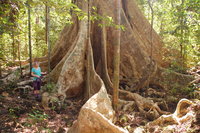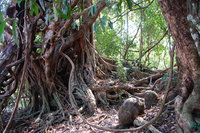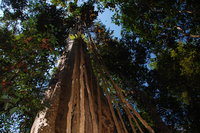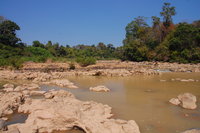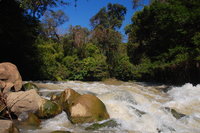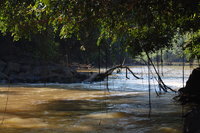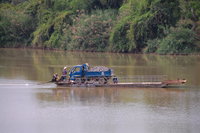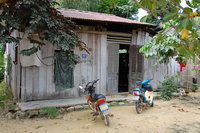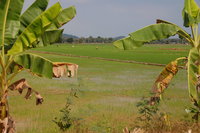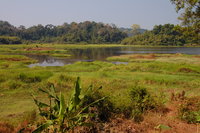So, we had touted around Đà Lạt asking opinions of lots of people as to how to get to Cát Tiên National Park. Many we had asked phoned up a bus company or two to try and figure out what we should do. After we had been doing this for a while, Megan pointed out that the bus companies would be wondering why there was a sudden stampede of people all wanting to go to the park. Despite all the phone calls, we could not get a straight answer about how to achieve this journey. In the end, we simply booked on a Saigon-bound bus. At the bus station, we told the driver what we wanted to do by repeating the phrase "ga chin" (which is how the place is pronounced) until we thought we saw a flash of recognition. Actually, to be fair, they are quite familiar with the process of dropping people at the roadside, so our request was nothing unusual.
About half way to Saigon, we were summoned to the front of the bus where we sat with the driver for a while before he pulled over at the side of the road and let us out. Google maps told us we were only about 20km away from where Steve expected us to be! Unsurprisingly, we were immediately accosted by a local with a motorbike offering to take us to the park. He wanted 300,000₫ each to take us and our luggage on his and his mate's motorbikes. We refused, insisting we wanted a taxi. Unsurprisingly, according to motorbike man, there are no taxis in this town. We dug in and set up in a local café and started to make motions of telephoning and emailing. After some repeated approaches, the motorbike man managed to locate a taxi (miraculous eh?). After even more negotiations, we secured said taxi for 400,000₫ for both of us. That is still £12, but it was a 20km ride to our accommodation at the Green Bamboo Lodge so we didn't feel too bad about the deal. Of course it was not a real taxi, just a mate of motorcycle man who happened to have a car.
Cát Tiên
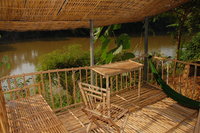
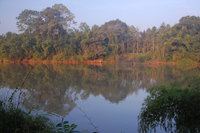
After the journey, we felt a certain sense of achievement in getting to the Green Bamboo Lodge and fortunately, the place did not disappoint. The lodge sits on the banks of the Đồng Nai river adjacent to the Cát Tiên National Park entrance. We checked in to a large riverside cabin made of bamboo with a bamboo veranda overlooking the river, complete with bamboo chairs and [not bamboo] hammock. It is always a bit of a punt when you reserve something on booking.com, but we did not want to come all this way and not be able to find anywhere to stay. At $16 per night including breakfast, we had our concerns, but they proved to be unfounded. The people were very friendly and helpful. There are bikes we can borrow and the entrance to the park is less than 100m away. We were also reassured that they could make all the arrangements for our onward journey to Saigon to catch a flight. And, yes, if we wanted to stay for more nights than we had booked, that was no problem either. They have a bamboo restaurant here and, rather surprisingly for somewhere so isolated, the prices are quite reasonable. They sell cold beer too which, with 35°C heat and near 100% humidity, is essential.
With the park right across the water, the alarm clock starts very early. Those weird birds that make a whooping noise are out in force and we can hear gibbons singing. There is also something that makes a constant whine like a cross between a burglar alarm and a dentist's drill but, hey, that's nature! By 7am, we are up and ready to go. This is not as bad as it sounds since bed time is about 8pm. It is also pretty wise as the temperature starts to climb as soon as the sun rises.
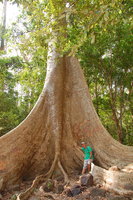
The park comprises about 720km² of lowland tropical forest and is one of the most important in Vietnam (although you wouldn't know it - read on). In addition to the jungle or forest there are large areas of bamboo and grassland. These are the areas that received the most defoliants (such as Agent Orange) although subsequent logging is also to blame for the lack of large hardwood trees. In 1992 Javan rhinoceros were discovered in the park (one of only two populations in the world) and it took the ever restrained Vietnamese until 2010 to poach them into extinction. The cause was cited as ineffective and inadequate protection by the park authorities. Nowadays, other than some deer and a few monkeys, there seems to be little wildlife left - everything has been sold or eaten. There are the aforementioned gibbons performing alarm clock duty, but these have been reintroduced by a local primate rescue centre founded and run by Brits from Monkey World Ape Rescue Centre in Dorset, UK.
Apparently, there is an uneasy relationship between the local authorities responsible for operating the park and anyone with an interest in actually preserving or improving the lot of the flora and fauna therein. Most attempts to actually do anything are blocked by bureaucracy - presumably any detailed work would reveal how the park is declining and being exploited. We have our own experience of what the management of the park is really focused on. In addition to the 40,000₫ to enter the park, if you want to visit the popular attraction that is Crocodile Lake, you have to pay 150,000₫ to hire a bicycle and an additional 200,000₫ for the privilege of cycling part of the way there and then walking the rest. That is 700,000₫ for the two of us. That would buy a meal out for two (with wine) in a decent Saigon restaurant...and also pay for a night's accommodation with breakfast at the Green Bamboo Lodge. If you want to visit the primate rescue centre (run by the Brits remember) for an hour's look around, then that is the same cost again. Needless to say, these costs only apply to foreigners. If you try and walk around the park on your own, there is a good chance you will get lost in the forest since the paths are woefully maintained. In fact it appears that nothing has been done maintenance-wise since the Americans reduced the place to a smouldering Hieronymus Bosch landscape.
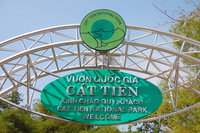
Despite the appalling gouging by the authorities, we had a good time exploring as much of the park as is practical. Since it is so hot and humid here, there is a limit to what can be achieved in a day, but trying to work around the ludicrous park rules provided some amusement. We were supplied with a map in Vietnamese (there is no plan to get an English version), where all the paths and sights of interest were incorrectly labelled. To be fair, the road-side signs also pointed in the wrong directions, so at least they are consistent in their inaccuracy. We thought the practice of installing misleading street furniture stopped after the Americans were ousted. It is worth observing that the WWF have withdrawn any involvement from the park and the place is in danger of losing its national park status anyway. Amusingly, a new park entry sign has just been erected resplendent with the park logo which is...a rhinoceros. Go authorities!
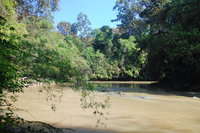
Another amusing aspect to our exploration was that we spent quite a bit of time walking along the Đồng Nai river looking for the so-called rapids. Given that we had gone out of our way to come to Vietnam in the dry season, this seemed rather ironic. We did observe though, that it would have been horrendous trying to explore the park in the wet season. There is a particular kind of earth here that you just know would be heavy and cloying when soaked. As it was, it had not completely dried out from the last wet season and the tracks were muddy and rutted in places. And all this is before you consider that the ever-helpful authorities will rent you some leech socks if you want them. What can you say about leech socks? They are the sort of thing you have never heard of and yet instantly understand [and hate] when you finally encounter them. Despite the mud, it is possible to observe that the ground is made up of some kind of black volcanic rock. Megan pointed out that it may not actually be volcanic, but simply the after effects of all that napalm!
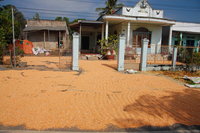
Whilst it is free to borrow the lodge's bicycles, it is not allowed to bring them into the park. It used to be permitted, or you could rent one inside for 20,000₫. Now it is not permitted, which is why the rental cost is now 150,000₫. This resulted in a day's cycling around the villages outside the park, which revealed some interesting facts. It appears to be sweetcorn harvesting time right now so large portions of the road surface are given over to drying the corn. It seemed a bit rude to cycle through the middle of it!
It also seems that the lamppost mounted loud-speakers are more active out here in the countryside. They seem to rant on all day exhorting the locals to...do stuff by numbers. Presumably country folk need more controlling then their urban cousins. Whilst we could not understand the exhortations, somewhere in the middle of it all was the phrase "hi-di-hi" which, bearing in mind it was coming from a speaker on a pole, lent an air of the surreal to an otherwise deeply communist activity (apologies to our overseas readers, Google is your friend).
Steve cycled about 20km out into the countryside to a minority S'tieng village. It was hot, dusty and uncomfortable, rather like life in the village it seems. Even without understanding Vietnamese, it was apparent that these people speak a different dialect. They are also extraordinarily poor. None the less, everyone wanted to say "hi" and the children would run out into the street waving and shouting hello and goodbye. Which is nice.
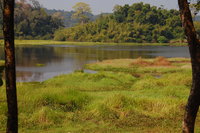
We weighed up the pros and cons (but mainly the cost) of going to the famous Crocodile Lake. Feedback from other people at our lodge was mixed with some trying to put on a brave face on having incurred the expense and others indicating it was a bit underwhelming. In the end we decided to walk from our lodge to the lake and back, a round trip of about 28km. Leaving before 8am meant that we beat the heat on the way out, but it was a bit on the hot side on the return leg. The lake itself is not up to much (but then it is the dry season). We did see a crocodile, but we've seen plenty of them in better locations. Megan's verdict - "it's a bit rubbish". It was a good yomp though and we saw large swathes of the jungle, certainly enough to observe that it is all green and looks the same. Since we didn't need bicycles, we didn't have to go to the park office where the ripping-off occurs.
Cát Tiên is an odd place. It was really nice to stay somewhere that is not undergoing construction. That does not mean it is peaceful by any means, but the night-time sounds are soothing rather than bone-jarring. It was certainly relaxing, even though it is fearsomely hot and humid. The park authorities go out of their way to spoil the place, but they do not entirely manage the task (like many others). Whilst there is hardly any wildlife left here, the place still makes a nice destination and a relaxing change - if you can be bothered to make the journey.
Next time, we will be in Saigon for a few days having a really good shower and picking off a few of the sights whilst we wait for a flight.
Some Pictures
